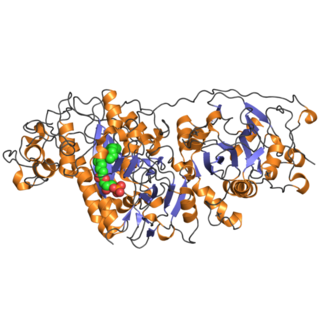
Lysophosphatidic acid (LPA) is a phospholipid derivative that can act as a signaling molecule.
The lysophospholipid receptor (LPL-R) group are members of the G protein-coupled receptor family of integral membrane proteins that are important for lipid signaling. In humans, there are eight LPL receptors, each encoded by a separate gene. These LPL receptor genes are also sometimes referred to as "Edg".

Autotaxin, also known as ectonucleotide pyrophosphatase/phosphodiesterase family member 2, is an enzyme that in humans is encoded by the ENPP2 gene.

Lysophosphatidic acid receptor 1 also known as LPA1 is a protein that in humans is encoded by the LPAR1 gene. LPA1 is a G protein-coupled receptor that binds the lipid signaling molecule lysophosphatidic acid (LPA).

Sphingosine-1-phosphate receptor 3 also known as S1PR3 is a human gene which encodes a G protein-coupled receptor which binds the lipid signaling molecule sphingosine 1-phosphate (S1P). Hence this receptor is also known as S1P3.

Probable G-protein coupled receptor 12 is a protein that in humans is encoded by the GPR12 gene.

N-Arachidonyl glycine receptor, also known as G protein-coupled receptor 18 (GPR18), is a protein that in humans is encoded by the GPR18 gene. Along with the other previously "orphan" receptors GPR55 and GPR119, GPR18 has been found to be a receptor for endogenous lipid neurotransmitters, several of which also bind to cannabinoid receptors. It has been found to be involved in the regulation of intraocular pressure.

Lysophosphatidic acid receptor 4 also known as LPA4 is a protein that in humans is encoded by the LPAR4 gene. LPA4 is a G protein-coupled receptor that binds the lipid signaling molecule lysophosphatidic acid (LPA).

G-protein coupled receptor 31 also known as 12-(S)-HETE receptor is a protein that in humans is encoded by the GPR31 gene. The human gene is located on chromosome 6q27 and encodes a G-protein coupled receptor protein composed of 319 amino acids.

Ovarian cancer G-protein coupled receptor 1 is a protein that in humans is encoded by the GPR68 gene.

Lysophosphatidic acid receptor 2 also known as LPA2 is a protein that in humans is encoded by the LPAR2 gene. LPA2 is a G protein-coupled receptor that binds the lipid signaling molecule lysophosphatidic acid (LPA).

Lysophosphatidic acid receptor 6, also known as LPA6, P2RY5 and GPR87, is a protein that in humans is encoded by the LPAR6 gene. LPA6 is a G protein-coupled receptor that binds the lipid signaling molecule lysophosphatidic acid (LPA).

Probable G-protein coupled receptor 45 is a protein that in humans is encoded by the GPR45 gene.

Hydroxycarboxylic acid receptor 1 (HCA1), formerly known as G protein-coupled receptor 81 (GPR81), is a protein that in humans is encoded by the HCAR1 gene. HCA1, like the other hydroxycarboxylic acid receptors HCA2 and HCA3, is a Gi/o-coupled G protein-coupled receptor (GPCR). The primary endogenous agonist of HCA1 is lactic acid (and its conjugate base, lactate).

Probable G-protein coupled receptor 63 is a protein that in humans is encoded by the GPR63 gene.

Pyroglutamylated RFamide peptide receptor also known as orexigenic neuropeptide QRFP receptor or G-protein coupled receptor 103 (GPR103) is a protein that in humans is encoded by the QRFPR gene.

Probable G-protein coupled receptor 62 is a protein that in humans is encoded by the GPR62 gene.

G-protein coupled receptor 120 is a protein that in humans is encoded by the GPR120 gene.

Lysophosphatidic acid receptor 3 also known as LPA3 is a protein that in humans is encoded by the LPAR3 gene. LPA3 is a G protein-coupled receptor that binds the lipid signaling molecule lysophosphatidic acid (LPA).

Thyroid receptor-interacting protein 6 is a protein that in humans is encoded by the TRIP6 gene.



















